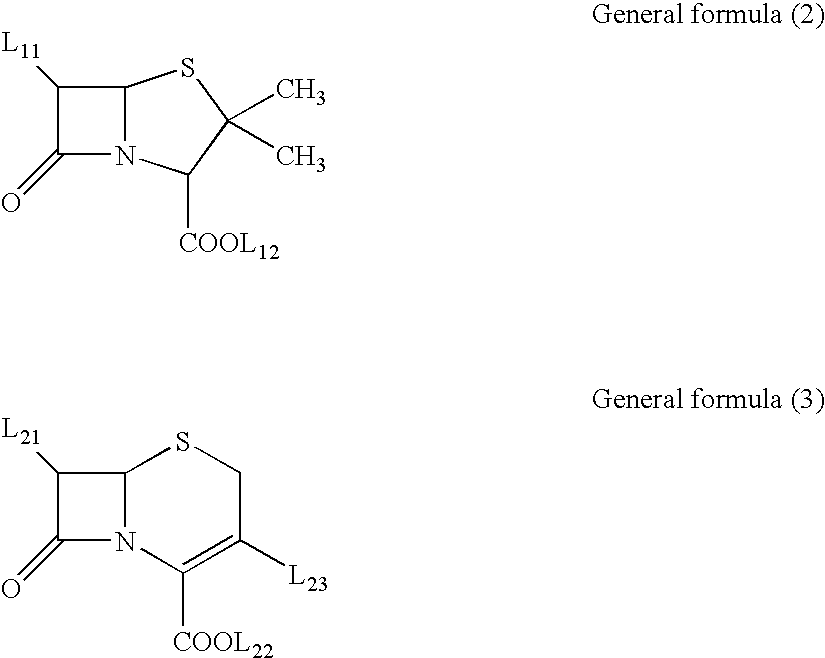Photothermographic material
a technology of photothermographic materials and materials, applied in the field of photothermographic materials, can solve the problems of reducing sensitivity, no hard copy system has reached a level, and no image satisfactory hard copy system, and achieve the effects of high image density, excellent image storage stability, and sufficient sensitivity for laser exposur
- Summary
- Abstract
- Description
- Claims
- Application Information
AI Technical Summary
Benefits of technology
Problems solved by technology
Method used
Image
Examples
example 1
1. Preparation of PET Support and Undercoating
1-1. Film Forming
[0331] PET having an intrinsic viscosity IV=0.66 (measured at 25° C. in phenol / tetrachlorethane=6 / 4 (ratio by weight)) was obtained in accordance with an ordinary preparation method by using terephthalic acid and ethylene glycol. After the thus-obtained PET is pelletized, the resultant pellets were dried at 130° C. for 4 hours. Then, the pellets of PET were melted at 300° C. and allowed to contain 0.04% by weight of Dye BB having a structure described below. Thereafter, the resultant PET was extruded from a T-type die, and rapidly quenched, thereby preparing an unstretched film having a film thickness of 175 μm after thermal fixation.
[0332] The thus-prepared film was stretched up to 3.3 times in the machine direction with rollers having different peripheral velocities, then up to 4.5 times in the transverse direction by means of a tenter. The temperatures at the time of such stretching were 110° C. and 130° C. resp...
example 2
1) Preparation of Coating Solution for Photosensitive Layer
[0363] As shown in Example 1, to 500 g of each of dispersions of organic silver salt containing respective Emulsions 1 to 3, 100 g of MEK was added with stirring in an atmosphere of a nitrogen gas flow, and stored at 24° C. Thereafter, to the resultant mixture, 2.5 ml of a 10% by mass methanol solution of Antifoggant-1 described below was added and then, stirred for 15 minutes. Thereafter, to the resultant solution, 1.8 ml of a methanol solution in which 20% by mass of a dye-adsorption assistant and 10% by mass of potassium acetate are contained was added and then, stirred for 15 minutes. Next, to the resultant mixture, a Sensitizing Dye-2 in an amount of 1.0×10−3 mol per mol of silver halide, 7 ml of a mixed solution of 4-chloro-2-benzoyl benzoic acid and 5-methyl-2-mercaptobenzimidazole as a super-sensitizer (mixing ratio=25:2 by mass; a methanol solution of 3.0% by mass in total), 2-tribromomethylsulfonyl quinoline in a...
example 3
[0375] Photothermographic materials 3-1 to 3-32 were prepared in the same manner as in Example 1 except that Sensitizing Dye-1 was not used.
[0376] The thus-prepared samples were exposed by xenon flash light via a light coherent filter having a peak at a wavelength of 410 nm, through a stepwedge for an illumination period of 10−6 second. This exposure condition is suitable for evaluating a performance toward a blue-color semiconductor lazer.
[0377] After exposed, samples were subjected to thermal development at 124° C. for 15 seconds with an automatic processor having a heat drum in a manner similar to that in Example 1 such that a protective layer of the photosensitive material and a surface of the drum were allowed to contact with each other. The obtained results were evaluated in the same manner as in Example 1 and are shown in Table 3.
TABLE 3Sensitizing Agent of present inventionPhotographicImage storabilityPhoto-Silver halide emulsionAdditionpropertiesStorabilityafter thermal...
PUM
| Property | Measurement | Unit |
|---|---|---|
| grain size | aaaaa | aaaaa |
| temperature | aaaaa | aaaaa |
| grain diameter | aaaaa | aaaaa |
Abstract
Description
Claims
Application Information
 Login to View More
Login to View More - R&D
- Intellectual Property
- Life Sciences
- Materials
- Tech Scout
- Unparalleled Data Quality
- Higher Quality Content
- 60% Fewer Hallucinations
Browse by: Latest US Patents, China's latest patents, Technical Efficacy Thesaurus, Application Domain, Technology Topic, Popular Technical Reports.
© 2025 PatSnap. All rights reserved.Legal|Privacy policy|Modern Slavery Act Transparency Statement|Sitemap|About US| Contact US: help@patsnap.com



